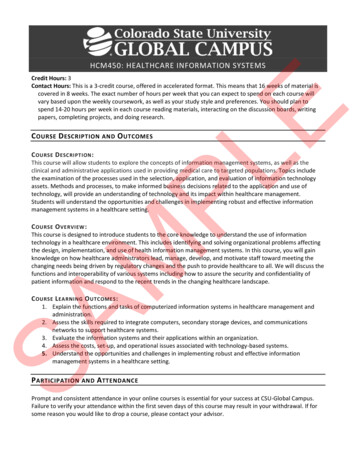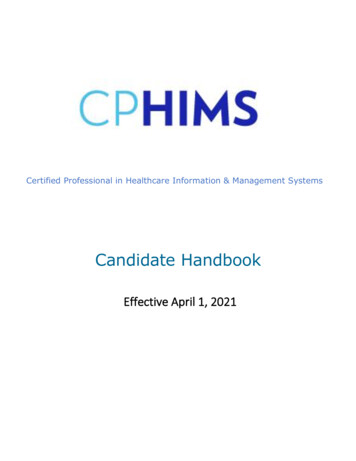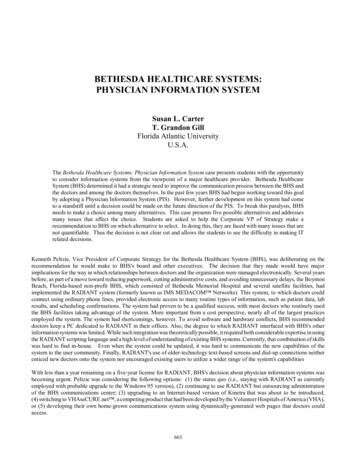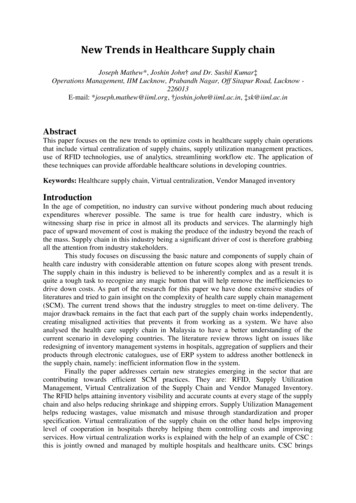
Transcription
HCM450: HEALTHCARE INFORMATION SYSTEMSC OURSE D ESCRIPTION :PLC OURSE D ESCRIPTION AND O UTCOMESECredit Hours: 3Contact Hours: This is a 3-credit course, offered in accelerated format. This means that 16 weeks of material iscovered in 8 weeks. The exact number of hours per week that you can expect to spend on each course willvary based upon the weekly coursework, as well as your study style and preferences. You should plan tospend 14-20 hours per week in each course reading materials, interacting on the discussion boards, writingpapers, completing projects, and doing research.This course will allow students to explore the concepts of information management systems, as well as theclinical and administrative applications used in providing medical care to targeted populations. Topics includethe examination of the processes used in the selection, application, and evaluation of information technologyassets. Methods and processes, to make informed business decisions related to the application and use oftechnology, will provide an understanding of technology and its impact within healthcare management.Students will understand the opportunities and challenges in implementing robust and effective informationmanagement systems in a healthcare setting.C OURSE O VERVIEW :MThis course is designed to introduce students to the core knowledge to understand the use of informationtechnology in a healthcare environment. This includes identifying and solving organizational problems affectingthe design, implementation, and use of health information management systems. In this course, you will gainknowledge on how healthcare administrators lead, manage, develop, and motivate staff toward meeting thechanging needs being driven by regulatory changes and the push to provide healthcare to all. We will discuss thefunctions and interoperability of various systems including how to assure the security and confidentiality ofpatient information and respond to the recent trends in the changing healthcare landscape.C OURSE L EARNING O UTCOMES :SA1. Explain the functions and tasks of computerized information systems in healthcare management andadministration.2. Assess the skills required to integrate computers, secondary storage devices, and communicationsnetworks to support healthcare systems.3. Evaluate the information systems and their applications within an organization.4. Assess the costs, set-up, and operational issues associated with technology-based systems.5. Understand the opportunities and challenges in implementing robust and effective informationmanagement systems in a healthcare setting.P ARTICIPATION AND A TTENDANCEPrompt and consistent attendance in your online courses is essential for your success at CSU-Global Campus.Failure to verify your attendance within the first seven days of this course may result in your withdrawal. If forsome reason you would like to drop a course, please contact your advisor.
Online classes have deadlines, assignments, and participation requirements just like on-campus classes. Budgetyour time carefully and keep an open line of communication with your instructor. If you are having technicalproblems, problems with your assignments, or other problems that are impeding your progress, let yourinstructor know as soon as possible.C OURSE M ATERIALSETextbook Information is located in the CSU-Global Booklist on the Student Portal.C OURSE S CHEDULEDue DatesThe Academic Week at CSU-Global begins on Monday and ends the following Sunday. Discussion Boards: The original post must be completed by Thursday at 11:59 p.m. MT, and peerresponses posted by Sunday 11:59 p.m. MT. Late posts may not be awarded points.Opening Exercises: Take the Opening Exercise before reading each week’s content to see which areasyou will need to focus on. You may take these exercises as many times as you need. The OpeningExercises will not affect your final grade.Mastery Exercises: Students may access and retake Mastery Exercises through the last day of class untilthey achieve the scores they desire.Critical Thinking: Assignments are due Sunday at 11:59 p.m. MT.PL W EEKLY R EADING AND A SSIGNMENT D ETAILSMM ODULE 1Readings Chapter 1 and 2 in Healthcare Information System Chazal, R., Casale, P., & Martin, G. (2016). Preparing for a value-based health caresystem. Journal of the American College of Cardiology, 68(15), 1698-1700. Conrad, D. (2015). The theory of value‐based payment incentives and their application to healthcare. Health Services Research, 50(6), 2057-2089.SAOpening Exercise (0 points)Discussion (25 points)Mastery Exercise (10 points)Critical Thinking (70 points)Choose one of the following two assignments to complete this week. Do not do both assignments.Identify your assignment choice in the title of your submission.Option #1: Patient-Centric HealthcareReview the following article on a patient-centric environment:Porter M., & Lee T. (2013). The strategy that will fix healthcare. Harvard Business Review. Retrieved -fix-health-care
Then create an infographic of the author’s key points using Canva that assesses the value and challengesof changing the payer model to an evidence-based approach, and defends the rationale and benefits forsharing information across systems.Your infographic should meet the following requirements:PL Portray key points visually—show, do not tell. For tips on how to create an effective infographic,review the following resources:o 12 Infographic Tips That You Wish You Knew Years Agoo Creating Infographics: 10 Tips and Tricks for Infographic Designerso Canva is a free tool that can be used to create infographics. For tutorials on how to usethis tool, review the following videos: Beginner’s Challenge Less is More Essential Canva Tools.Support your infographic with citations from the article, course text, and a minimum of twoadditional sources. The CSU-Global library is a good place to find these references. Include areference section at the bottom of the infographic that includes APA references for all citedsources. Format your citations and references according to the CSU-Global Guide to Writing andAPA.E Download your completed infographic from Canva as a PDF and submit the PDF for grading. Review thegrading rubric in the Module 1 folder for specific grading criteria.Option #2: Value-Based HealthcareReview the following article from this week’s required reading:MChazal, Casale, & Martin. (2016). Preparing for a value-based health care system. Journal of theAmerican College of Cardiology, 68(15), 1698-1700.Then create an infographic of the author’s key points using Canva that assesses the value and challengesof changing the payer model to an evidence-based approach and defends the rationale and benefits forsharing information across systems.Your infographic should meet the following requirements: SAPortray key points visually—show, do not tell. For tips on how to create an effective infographic,review the following resources:o 12 Infographic Tips That You Wish You Knew Years Agoo Creating Infographics: 10 Tips and Tricks for Infographic Designerso Canva is a free tool that can be used to create infographics. For tutorials on how to usethis tool, review the following videos: Beginner’s Challenge Less is More Essential Canva Tools.Support your infographic with citations from the article, course text, and a minimum of two additionalsources. The CSU-Global library is a good place to find these references. Include a reference section atthe bottom of the infographic that includes APA references for all cited sources. Format your citationsand references according to the CSU-Global Guide to Writing and APA.
Download your completed infographic from Canva as a PDF and submit the PDF for grading. Review thegrading rubric in the Module 1 folder for specific grading criteria.M ODULE 2Opening Exercise (0 points)Discussion (25 points)Mastery Exercise (10 points)EReadings Chapter 3 and 5 in Healthcare Information System Farzandipour, M., Meidani, Z., Gilasi, H., & Dehghan, R. (2017). Evaluation of key capabilities forhospital information system: A milestone for meaningful use of information technology. Annalsof Tropical Medicine and Public Health, 10(6), 1579-1586. Pergher, I., Brandolf, V., Pacheco, D., Vaccaro, G., & Nisar, T. (2016). A patient-centric approachto improve health care services. Cogent Business & Management, 3(1), 1-17.PLPortfolio Milestone (50 points)Choose one of the following two milestones to complete this week. Do not do both assignments.Identify your assignment choice in the title of your submission.Option #1: Annotated BibliographyDetermine which option you will research for your final project. For Option #1, research thedevelopment of a project plan. Identify five recent resources (no more than five years old) that will beused to support your final project. The CSU-Global library is a good place to find these references. Thencreate an annotated bibliography that includes: M The APA reference for each resource you have selected, formatted according to the CSU-GlobalGuide to Writing and APA.A one-paragraph summary of each resource that explains both the information presented theresource and how that information will be used to support your final portfolio project. (List thereference, then the summary—an additional reference page is not required.)SAOption #2: Annotated BibliographyDetermine which option you will research for your final project. For Option #2, research emergingtechnologies and healthcare reform for the 21st century. Identify five recent resources (no more thanfive years old) that will be used to support your final project. Then create an annotated bibliography thatincludes: The APA reference for each resource you have selected, formatted according to the CSU-GlobalGuide to Writing and APA.A one-paragraph summary of each resource that explains both the information presented theresource and how that information will be used to support your final portfolio project. (List thereference, then the summary—an additional reference page is not required.)M ODULE 3Readings Chapter 6 and Case Study #9 (p. 492) in Healthcare Information Systems Review Chapter 5 in Healthcare Information Systems Harris, C., Garrubba, M., Allen, K., King, R., Kelly, C., Thiagarajan, M., Castleman, B., Ramsey,W., & Farjou, D. (2015). Development, implementation and evaluation of an evidence-based
program for introduction of new health technologies and clinical practices in a local healthcaresetting. BMC Health Services Research, 15, 575-592.Lever, R. (2017). Artificial intelligence and the coming health revolution. Medical DesignTechnology.Opening Exercise (0 points)Discussion (25 points)Mastery Exercise (10 points)ECritical Thinking (80 points)Choose one of the following two assignments to complete this week. Do not do both assignments.Identify your assignment choice in the title of your submission.PLOption #1: Personal Interview – Hospital EmployeeIdentify a person who works in any department of a hospital of any size—it could also be someone fromthis class who works in a hospital, so review the introductions from the beginning of class as a startingpoint.MDevelop five to six interview questions focused on the challenges that they face with the use oftechnology in their department, how they get work done, what has improved, and what needsimproving, for example. For instance, in an interview with a nurse you might ask how he or sheannotates on a patient’s chart and communicates with other nurses or other departments in thehospital; in an interview with an administrator you may ask how he or she measures performance of thedepartment and what information is maintained within the department versus shared. Prepare asummary of your discussion highlighting how this person uses technology today, what works well or not,and what the interviewee would like to see regarding technology for the future of their role/jobfunction. Then create a recommendation for the implementation of a new technology that wouldresolve one of the issues identified by the interviewee. The recommendation should assess the setupand costs that would be required for the new system.Your paper should meet the following requirements: SA Three to four pages in length, not including the title page.Include the list of your questions asked during the interview.Summarize your findings: What did you learn from the discussion? Were you surprised by theinformation?Include your recommendation for the implementation of a new technology that would resolveone the issues discussed during the interview.Format your paper according to the CSU-Global Guide to Writing and APA. Review the grading rubric in the Module 3 folder for specific grading criteria.Option #2: Personal Interview – General Practitioner EmployeeIdentify a person who works in a general practitioner’s office, surgery center, or urgent care.Develop five to six interview questions focused on the challenges that they face with developingstrategies for their systems: What is working well? What is not working well? How do they see theirproducts developing over the next two years? Prepare a summary of your discussion highlighting howthis person makes product decisions based upon customer feedback or the voice of the customer today.Identify what kinds of applications or functions customers are asking for now and predicted in thefuture. Then create a recommendation for the implementation of a new technology that would resolve
one of the issues identified by the interviewee. The recommendation should assess the setup and coststhat would be required for the new system.Your paper should meet the following requirements: Two to three pages in length, not including the title page.Include the list of your questions asked during the interview.Summarize your findings: What did you learn from the discussion? Were you surprised by theinformation?Include your recommendation for the implementation of a new technology that would resolveone the issues discussed during the interview.Format your paper according to the CSU-Global Guide to Writing and APA.E Review the grading rubric in the Module 3 folder for specific grading criteria.M ODULE 4PLReadings Chapters 7 and 8 in Healthcare Information Systems Hewitt, J. (2016). The role of data, analytics and insights in health care. Chain DrugReview, 38(12), 14. Kondo, K., Damberg, K., Mendelson, A., Motu’apuaka, M., Freeman, M., O’Neil, M., Relevo, R.,Low, A., & Kansagara, D. (2016). Implementation processes and pay for performance inhealthcare: A systematic review. Journal of General Internal Medicine, 31(1), 61-69. Van Laere, J. (2016). Understanding champion behavior in a health-care information systemdevelopment project – how multiple champions and champion behaviors build a coherentwhole. European Journal of Information Systems, 25(1), 47-63.Opening Exercise (0 points)MDiscussion (25 points)Mastery Exercise (10 points)Critical Thinking (70 points)Choose one of the following two assignments to complete this week. Do not do both assignments.Identify your assignment choice in the title of your submission.SAOption #1: EMR Training PlanReview the Kondo article from your required reading:Kondo, K., Damberg, K., Mendelson, A., Motu’apuaka, M., Freeman, M., O’Neil, M., Relevo, R., Low, A., &Kansagara, D. (2016). Implementation processes and pay for performance in healthcare: A systematicreview. Journal of General Internal Medicine, 31(1), 61-69.Then design a training plan that addresses the following: Identify various challenges that are present for small practices in implementing an electronicmedical record. Are these different from those affecting a large healthcare system? Explain whyyou think so.Identify the key stakeholders—who could benefit from training on the implementation of EMR?Outline a training strategy that will build the skills needed to effectively support and utilize anEMR.
Determine and explain key elements to be included in the training and frequency of training.EYour training plan should meet the following requirements: Four to five pages in length, not including the title and reference pages. Support your plan and points with a minimum of three sources in addition to the course text.Remember, you must support your thinking/opinions and prior knowledge with references; allfacts must be supported, and in-text citations used throughout the assignment must be includedin an APA-formatted reference list. The CSU-Global library is a good place to find thesereferences. Format your plan, citations, and references according to the CSU-Global Guide to Writing andAPA.Review the grading rubric in the Module 4 folder for specific grading criteria and reach out to yourinstructor if you have questions about the assignment.PLOption #2: Threats to HIT Training PlanData accuracy and security are crucial to the administration of electronic medical records. Threats to theuse of electronic medical records include physical loss or damage, crimes, viruses, and unauthorizedaccess.Select one of the following topics as it relates to electronic medical records: Health Systems SecurityHealth Systems QualityHealth Systems Privacy.MThen design a training plan that focuses on this topic and addresses the following: SA Identify various challenges that are present for small practices in implementing an electronicmedical record. Are these different from those affecting a large healthcare system? Explain whyyou think so.Identify the key stakeholders—who could benefit from training on the threat you selected,particularly as it relates to EMR?Outline a training strategy that will build the skills needed to effectively support and utilize anEMR.Determine and explain key elements to be included in the training and frequency of training.Your training plan should meet the following requirements: Four to five pages in length, not including the title and reference pages. Support your plan and points with a minimum of three sources in addition to the course text.Remember, you must support your thinking/opinions and prior knowledge with references; allfacts must be supported, and in-text citations used throughout the assignment must be includedin an APA-formatted reference list. The CSU-Global library is a good place to find thesereferences. Format your plan, citations, and references according to the CSU-Global Guide to Writing andAPA.
Review the grading rubric in the Module 4 folder for specific grading criteria and reach out to yourinstructor if you have questions about the assignment.M ODULE 5Opening Exercise (0 points)Discussion (25 points)Mastery Exercise (10 points)EReadings Chapters 9 and 10 in Healthcare Information Systems Brown, B., & Tijerina, D. (2015). 2013 HIPAA/HITECH amendments: How the changes impact theediscovery process. The Health Lawyer, 27(4), 21-27. Green, L. A., Potworowski, G., Day, A. May-Gentile, R., Vibbert, D., Maki, B., & Kiesel, L. (2015).Sustaining "meaningful use" of health information technology in low-resource practices. Annalsof Family Medicine, 13(1), 17-22.PLCritical Thinking (70 points)Choose one of the following two assignments to complete this week. Do not do both assignments.Identify your assignment choice in the title of your submission.Option #1: Emerging Technologies and Their Uses in HealthcareReview the Privacy and Security page on the HealthIT.gov website.Choose at least four of the reading or video options focused on securing patient information usingmobile devices. Then prepare a presentation in PowerPoint, Prezi, or another online tool that meets orexceeds the following requirements:Read or watch the chosen content.Evaluate the value of these devices in your healthcare setting.Analyze how you would protect such technology and the information that it contains, using thisweek’s reading and your own research.Evaluate the importance of these products to healthcare delivery and the management ofchronic diseases such as asthma and diabetes.M Your presentation should include the following:Eight to ten slides, not including the cover and reference slide.Include a voiceover recording of your presentation that describes the content and how youwould present the information to others within the healthcare system. (Screencast-O-Matic is atool that pairs nicely with PowerPoint.)Support your presentation with a minimum of three sources in addition to the course text.Remember, you must support your thinking/opinions and prior knowledge with references; allfacts must be supported, and in-text citations used throughout the assignment must be includedin an APA-formatted reference list. The CSU-Global library is a good place to find thesereferences.Format your citations and references according to the CSU-Global Guide to Writing and APA.SA Review the grading rubric in the Module 5 folder for specific grading criteria and reach out to yourinstructor if you have questions about the assignment.
Option #2: Texas Health Case StudyRead the Davies Interoperability Case Study from Texas Health Resources.Prepare a presentation in PowerPoint, Prezi, or another online tool that meets or exceeds the followingrequirements: Summarize the strategy employed by Texas Health.Compare and contrast the value and challenges addressed by Texas Health. (Include the prosand cons of linking electronic health records (EHR) and how they addressed those challenges.)Evaluate how the meaningful use of information systems affected the decisions made andstrategies employed by Texas Health. Your presentation should include the following: Eight to ten slides, not including the cover and reference slide.Include a voiceover recording of your presentation that describes the content and how youwould present the information to others within the healthcare system. (Screencast-O-Matic is atool that pairs nicely with PowerPoint.)Support your presentation with a minimum of three sources in addition to the course text.Remember, you must support your thinking/opinions and prior knowledge with references; allfacts must be supported, and in-text citations used throughout the assignment must be includedin an APA-formatted reference list. The CSU-Global library is a good place to find thesereferences.Format your citations and references according to the CSU-Global Guide to Writing and APA.PL E Review the grading rubric in the Module 5 folder for specific grading criteria and reach out to yourinstructor if you have questions about the assignment.MM ODULE 6SAReadings Chapters 4, 12, and 13 in Healthcare Information Systems American College of Emergency Physicians. Health information technology standards. (2017).Annals of Emergency Medicine, 70(1), 117. Assadi, V., & Hassanein, K. (2017). Consumer adoption of personal health record systems: A selfdetermination theory perspective. Journal of Medical Internet Research, 19(7), E270. Statista. (n.d.) Health care applications for emerging technologies statistics & facts. Retrievedfrom pplications-for-emergingtechnologies/Opening Exercise (0 points)Discussion (25 points)Mastery Exercise (10 points)Critical Thinking (80 points)Choose one of the following two assignments to complete this week. Do not do both assignments.Identify your assignment choice in the title of your submission.Option #1: Apps for the Management of Chronic IllnessResearch three applications available for your mobile phone or tablet related to the management ofchronic illnesses. Then prepare a presentation using PowerPoint, Prezi, or another online tool that
describes what the apps are meant to monitor, defines the goals of the app, and describes the featuresor functions that allow it to manage information. Conclude with an evaluation and explanation ofwhether or not you would find it useful if you suffered from this chronic illness.Your presentation should include the following: PL Eight to ten slides, not including the cover and reference slide.A two- to four-minute voiceover recording of your presentation that describes the content andhow you would present the information to others within the healthcare system. (Screencast-OMatic is a tool that pairs nicely with PowerPoint.)Support your presentation with a minimum of three sources in addition to the course text.Remember, you must support your thinking/opinions and prior knowledge with references; allfacts must be supported, and in-text citations used throughout the assignment must be includedin an APA-formatted reference list. The CSU-Global library is a good place to find thesereferences.Format your citations and references according to the CSU-Global Guide to Writing and APA.E Review the grading rubric in the Module 6 folder for specific grading criteria and reach out to yourinstructor if you have questions about the assignment.Option #2: Online Patient EducationResearch a large health system that offers patient education online (i.e., the Cleveland Clinic, JohnsHopkins, or Mayo). Then prepare a presentation in PowerPoint, Prezi, or another online tool thatdescribes what education content is available for patients. Focus in on three areas for chronic illnessessuch as asthma, COPD, smoking cessation, or obesity. As a patient, would you find the informationuseful? Why or why not? Did you find the information easy to understand? What changes would youpropose for the usability and effectiveness of the website?MYour presentation should include the following: SA Eight to ten slides, not including the cover and reference slide.A two- to four-minute voiceover recording of your presentation that describes the content andhow you would present the information to others within the healthcare system. (Screencast-OMatic is a tool that pairs nicely with PowerPoint.)Support your presentation with a minimum of three sources in addition to the course text.Remember, you must support your thinking/opinions and prior knowledge with references; allfacts must be supported, and in-text citations used throughout the assignment must be includedin an APA-formatted reference list. The CSU-Global library is a good place to find thesereferences.Format your citations and references according to the CSU-Global Guide to Writing and APA. Review the grading rubric in the Module 6 folder for specific grading criteria and reach out to yourinstructor if you have questions about the assignment.M ODULE 7Readings Chapter 11 and Case Study #12 (p. 497) in Healthcare Information Systems Flynn, A. J., & Stevenson, J. G. (2018). The future of data, analytics, and information technology.American Journal of Health-System Pharmacy, 75(2), 31-34.
Mewborn, A. (2017). Health, care and wearable technologies. ISE; Industrial and SystemsEngineering at Work, 49(3), 22.Morrissey, J. (2015). Can you imagine? Amazing new health care technologies leap frominspiration to reality. Hospitals and Health Networks, 89(4), 22-7.Opening Exercise (0 points)Discussion (25 points)Mastery Exercise (10 points)M ODULE 8PLEReadings Chapter 4 and Case Study #1 (p. 468) in Healthcare Information Systems Dudley, L., Mukinda, F., Dyers, R., Marais, F., & Sissolak, D. (2018). Mind the gap! Risk factors forpoor continuity of care of TB patients discharged from a hospital in the Western Cape, SouthAfrica. PloS One, 13(1), E0190258. Lawton Smith, H., Bagchi-Sen, S., & Edmunds, L. (2016). Innovation capacity in the healthcaresector and historical anchors: Examples from the UK, Switzerland and the US. The Journal ofTechnology Transfer, 41(6), 1420-1439.Opening Exercise (0 points)Discussion (25 points)Mastery Exercise (10 points)Portfolio Project (300 points)Choose one of the following two assignments to complete this week. Do not do both assignments.Identify your assignment choice in the title of your submission.MOption #1: Project Plan for Choosing and Implementing a Departmental-Level Information SystemReview Chapter 6 in your text (Wager, Lee, & Glaswer, 2017) for a complete guide to systemimplementation. Based upon the information provided, prepare a project plan that addresses thefollowing requirements: SA Identify a problem in a healthcare setting that could be solved by the implementation of a newinformation management system. (The problem could be from your current workplace or aproblem that was identified through course readings and research.)Identify the stakeholders—who is impacted by the problem? How?Propose a solution to the problem and the system that would support this solution. Be sure toidentify the scope and goals of the project.Evaluate the costs, set-up, and operational issues that would be part of the technology-basedsystem.Explain in detail the project management process that will be utilized by your project and thestakeholders involved in each step of its implementation.Analyze which steps in your plan are the most critical and which are the most time-consuming.What strategies will be employed to manage these aspects of the project?Determine the criteria that will be used to measure whether or not the project is successful.Conclude with a summary of the ongoing maintenance, training, and support that will beneeded in order to make your project a continued success. Your paper should include the following:
Eight to ten pages in length, including the title and reference pages.Support your paper and points with a minimum of five sources in addition to the course text.Remember, you must support your thinking/opinions and prior knowledge with references; allfacts must be supported, and in-text citations used throughout the assignment must be includedin an APA-formatted reference list. The CSU-Global library is a good place to find thesereferences.Format your paper, citations, and references according to the CSU-Global Guide to Writing andAPA.EReview the grading rubric in the Module 8 folder for specific grading crite
o 12 Infographic Tips That You Wish You Knew Years Ago o Creating Infographics: 10 Tips and Tricks for Infographic Designers o Canva is a free tool that can be used to create infographics. For tutorials on how to use this tool, review the following videos:










